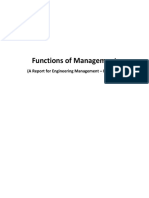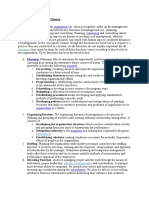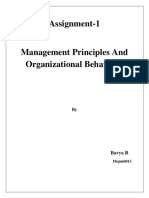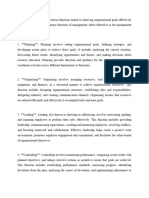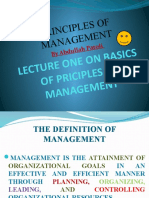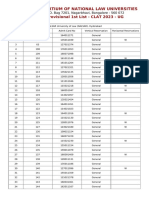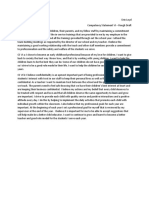Management is indeed a series of continuous, interrelated functions designed to coordinate the
efforts of people and resources to achieve organizational goals. The key functions of management
are commonly categorized into five main areas: Planning, Organizing, Leading, Controlling, and
Staffing. Here's a brief explanation of each function, along with how they are interconnected:
### 1. **Planning**
Planning is the first and foremost function of management. It involves setting objectives and
determining a course of action for achieving those objectives. During planning, managers assess the
current situation, forecast future conditions, and decide on the best strategies to achieve
organizational goals.
**Connection to Other Functions:**
- Planning provides direction for the organizing process by clearly defining what needs to be
accomplished.
- Quality planning informs staffing needs, as it outlines the skills and resources required to achieve
objectives.
### 2. **Organizing**
Once planning is complete, the next step is organizing. This involves arranging resources (human,
financial, physical) and tasks in a way that helps in the execution of the plan. Organizing also includes
establishing a structure of roles and responsibilities.
**Connection to Other Functions:**
- Organizing relies on the planning function to clarify what resources are necessary and how they
should be allocated.
- A well-organized structure facilitates effective leading, as it clearly defines roles and
communication channels.
### 3. **Staffing**
Staffing focuses on recruiting, training, and developing individuals to fill the roles that have been
established during the organizing phase. It ensures that the right people are in the right positions to
execute the plan effectively.
�**Connection to Other Functions:**
- Staffing decisions are guided by the requirements identified in the planning process and the
structure set up during organizing.
- Good staffing enhances leading, as a well-trained team can be more easily inspired and motivated
to achieve organizational goals.
### 4. **Leading**
Leading involves directing and motivating employees to work towards the organization’s goals. This
function includes communication, leadership styles, and employee performance management.
Effective leadership is essential for fostering a positive work environment and stimulating workforce
enthusiasm.
**Connection to Other Functions:**
- Leading is influenced by how well the planning, organizing, and staffing functions have been
executed. If clear plans are not established or if roles are poorly defined, leading becomes more
challenging.
- Feedback from the leading process informs the controlling function, as leaders must ensure that
activities are aligned with the objectives set during planning.
### 5. **Controlling**
Controlling is the final function of management, which involves monitoring and evaluating progress
toward the goals set in the planning stage. It includes setting performance standards, measuring
actual performance, and taking corrective actions if necessary.
**Connection to Other Functions:**
- Controlling relies on the plans made earlier, as it requires standards and benchmarks to measure
performance against.
- The outcomes of controlling can lead to adjustments in planning and organizing, creating a
feedback loop to improve overall management effectiveness.
### Conclusion
These management functions are dynamic and interconnected. Effective management is not a linear
process but rather a continuous cycle where each function influences and informs the others. For
�instance, control feedback may lead to revised plans, which in turn may require organizational
restructuring or adjustments in staffing. This interdependence highlights the importance of a holistic
approach to management, where each function is considered in the context of the whole
organization.








